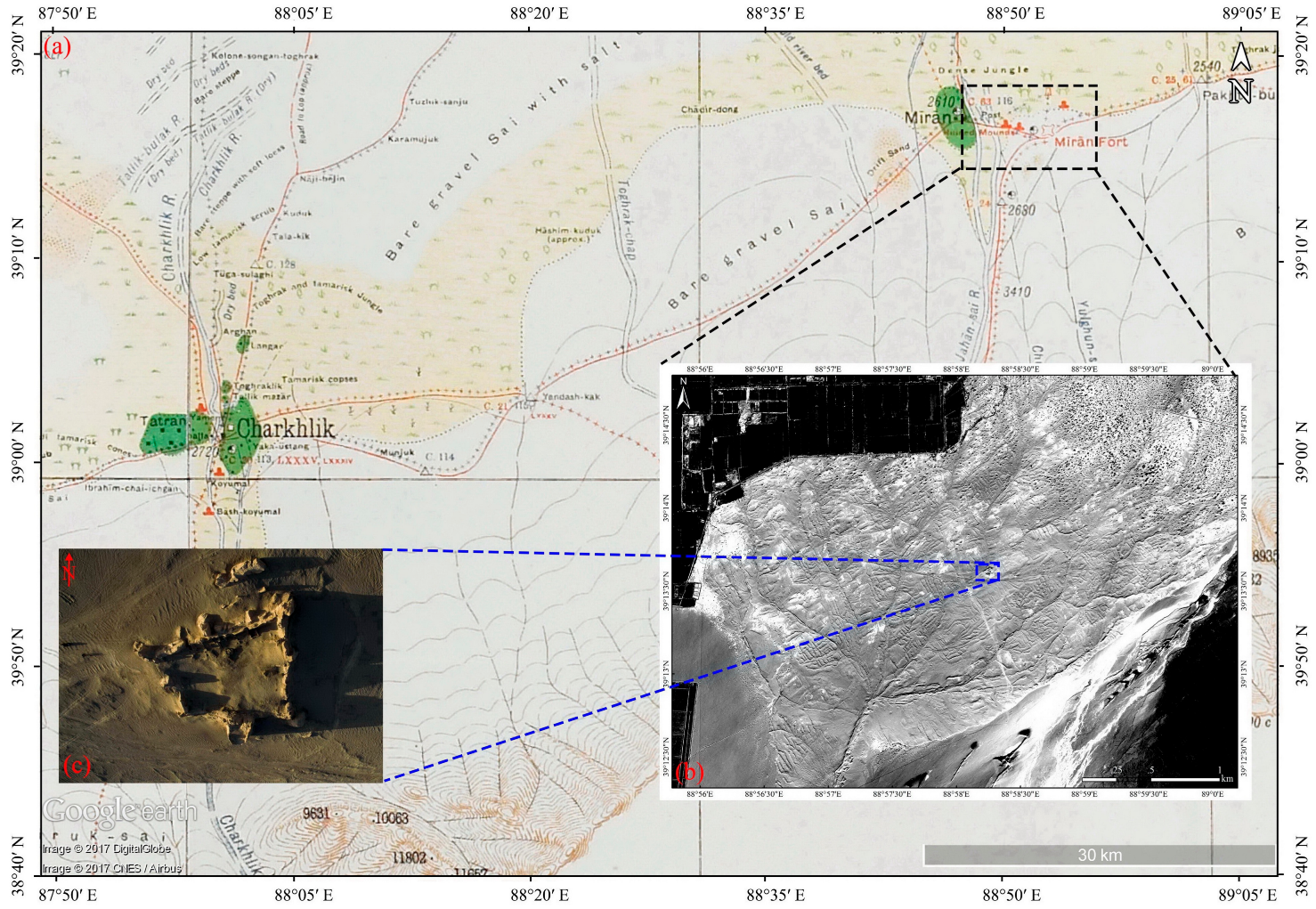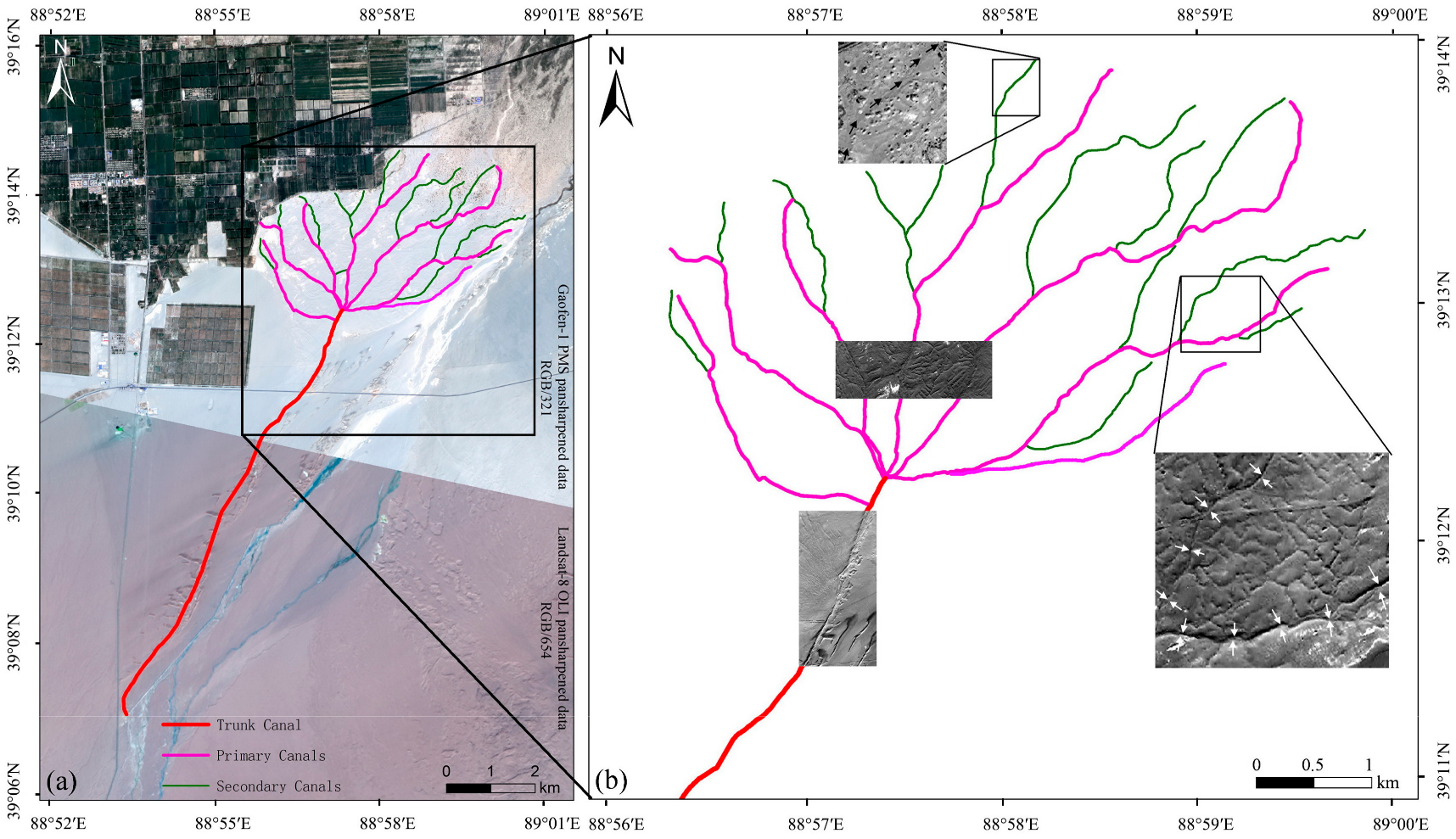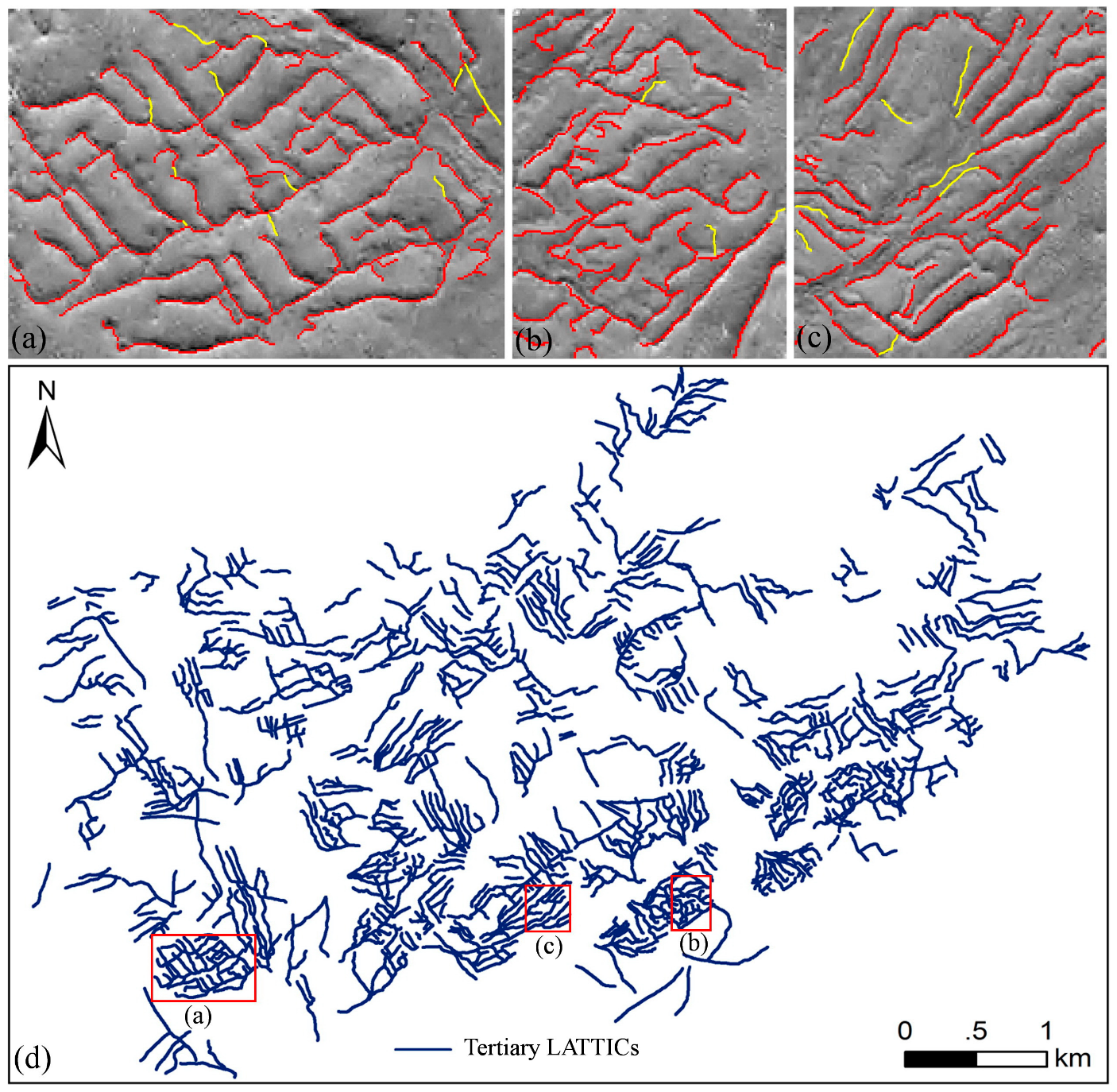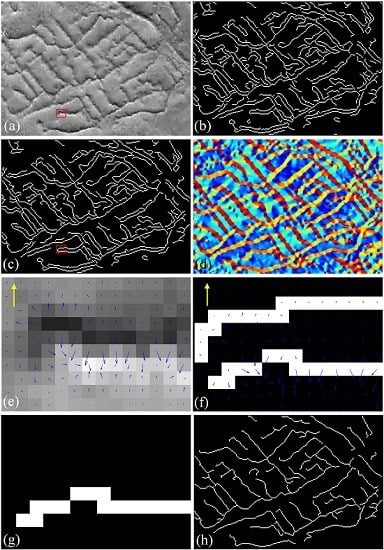Auto-Extraction of Linear Archaeological Traces of Tuntian Irrigation Canals in Miran Site (China) from Gaofen-1 Satellite Imagery
Abstract
:1. Introduction
2. Materials
2.1. Miran Site
2.2. Remote Sensing Data
2.3. LATTICs in Miran Site
3. Methods
3.1. Data Pre-Processing
3.2. Spectral Separability Analysis
3.3. Mathematical Morphology Based Image Enhancement
3.4. Improved Edge Detection Based on the Canny Operator
3.5. Mapping the Tertiary LATTICs
4. Results and Discussion
4.1. Spectral Separability Analysis of LATTICs
4.2. Morphological Enhancement
4.3. Automatic Detection of Tertiary LATTICs
4.4. Performance Evaluation
4.5. Mapping the LATTICs in Miran Site
5. Conclusions
Author Contributions
Acknowledgments
Conflicts of Interest
References
- Elisseeff, V. The Silk Roads: Highways of Culture and Commerce; Berghahn Books: New York, NY, USA, 2000. [Google Scholar]
- Ban, G. HanShu; Zhonghua Book Company: Beijing, China, 92; reprint in 1962. (In Chinese) [Google Scholar]
- Luo, L.; Wang, X.; Liu, J.; Guo, H.; Lasaponara, R.; Ji, W. Uncovering the ancient canal-based Tuntian agricultural landscape at China’s northwestern frontiers. J. Cult. Herit. 2017, 23, 79–88. [Google Scholar] [CrossRef]
- Luo, L. Space Archaeology for Tunshu Sites along the South Route of the Ancient Silk Road. Ph.D. Thesis, University of Chinese Academy of Sciences, Beijing, China, 30 June 2016. (In Chinese). [Google Scholar]
- Sima, Q. Shiji; Zhonghua Book Company: Beijing, China, 91 B.C.; reprint in 1962. (In Chinese) [Google Scholar]
- Zhang, D. Station troops to open-up wasteland of western region in the Han dynasty based on the Han slips from Xuanquan. Dunhuang Res. 2001, 3, 113–121. (In Chinese) [Google Scholar]
- Xia, X.; Wang, B.; Zhao, Y. Lop Nor in China; Science Press: Beijing, China, 2007. (In Chinese) [Google Scholar]
- Zhang, J.; Lü, H.; Wu, N.; Qin, X.; Wang, L. Paleoenvironment and agriculture of ancient Loulan and Milan on the Silk Road. Holocene 2012, 23, 208–217. [Google Scholar] [CrossRef]
- Stein, A. Innermost Asia: Detailed Report of Explorations in Central Asia, Kansu and Eastern Iran, Carried Out and Described under the Orders of H. M. Indian Government; Clarendon Press: Oxford, UK, 1928. [Google Scholar]
- Wang, S. Historical status of the capital Loulan and ancient Lop Nor region. West Reg. Stud. 1996, 4, 43–53. (In Chinese) [Google Scholar]
- Chen, Z. Lop Nor and Lop Desert. Acta Geogr. Sin. 1936, 3, 18–49. (In Chinese) [Google Scholar]
- Lü, H.; Xia, X.; Liu, J.; Qin, X.; Wang, F.; Yidilisi, A.; Zhou, L.; Mu, G.; Jiao, Y.; Li, J. A preliminary study of chronology for a newly-discovered ancient city and five archaeological sites in Lop Nor, China. Chin. Sci. Bull. 2009, 55, 63–71. [Google Scholar] [CrossRef]
- Xiao, X. Summary of archaeology in Loulan-Shanshan. West Reg. Stud. 2006, 4, 82–92. (In Chinese) [Google Scholar]
- Noviello, M.; Ciminale, M.; Pasquale, V. Combined application of pansharpening and enhancement methods to improve archaeological cropmark visibility and identification in QuickBird Imagery: Two case studies from Apulia, Southern Italy. J. Archaeol. Sci. 2013, 40, 3604–3613. [Google Scholar] [CrossRef]
- Atzberger, C.; Wess, M.; Doneus, M.; Verhoeven, G. ARCTIS—A MATLAB® Toolbox for archaeological imaging spectroscopy. Remote Sens. 2014, 6, 8617–8638. [Google Scholar] [CrossRef] [Green Version]
- Aminzadeh, B.; Samani, F. Identifying the boundaries of the historical site of Persepolis using remote sensing. Remote Sens. Environ. 2006, 102, 52–62. [Google Scholar] [CrossRef]
- Bini, M.; Isola, I.; Zanchetta, G.; Ribolini, A.; Ciampalini, A.; Baneschi, I.; Mele, D.; D’Agata, A. Identification of leveled archeological mounds (Höyük) in the Alluvial plain of the Ceyhan River (Southern Turkey) by satellite remote-sensing analyses. Remote Sens. 2018, 10, 241. [Google Scholar] [CrossRef]
- Lasaponara, R.; Masini, N. Detection of archaeological crop marks by using satellites QuickBird Multispectral Imagery. J. Archaeol. Sci. 2007, 34, 214–221. [Google Scholar] [CrossRef]
- Lasaponara, R.; Masini, N. Satellite Remote Sensing: A New Tool for Archaeology; Springer: Berlin, Germany, 2012. [Google Scholar]
- Agapiou, A.; Alexakis, D.; Sarris, A.; Hadjimitsis, D. Orthogonal equations of multi-spectral satellite imagery for the identification of un-excavated archaeological sites. Remote Sens. 2013, 5, 6560–6586. [Google Scholar] [CrossRef]
- Agapiou, A.; Lysandrou, V.; Lasaponara, R.; Masini, N.; Hadjimitsis, D. Study of the variations of archaeological marks at neolithic site of Lucera, Italy using high-resolution multispectral datasets. Remote Sens. 2016, 8, 723. [Google Scholar] [CrossRef]
- Bewley, R. Understanding the past. Aerial survey, remote sensing, interpretation and management. Archeologia Aerea Studi di Aerotopografia Archeologica 2004, 1, 37–45. [Google Scholar]
- Tarantino, E.; Figorito, B. Steerable filtering in interactive tracing of archaeological linear features using digital true color aerial images. Int. J. Digit. Earth 2014, 7, 870–880. [Google Scholar] [CrossRef]
- Ur, J. CORONA Satellite photography and ancient road networks: A Northern Mesopotamian case study. Antiquity 2003, 77, 102–115. [Google Scholar] [CrossRef]
- Beck, A.; Philip, G.; Abdulkarim, M.; Donoghue, D. Evaluation 17 of CORONA and IKONOS high resolution satellite imagery for archaeological prospection in Western Syria. Antiquity 2007, 81, 161–175. [Google Scholar] [CrossRef]
- Agapiou, A.; Alexakis, D.; Hadjimitsis, D. Spectral sensitivity of ALOS, ASTER, IKONOS, LANDSAT and SPOT satellite imagery intended for the detection of archaeological crop marks. Int. J. Digit. Earth 2014, 7, 351–372. [Google Scholar] [CrossRef]
- Agapiou, A.; Alexakis, D.; Sarris, A.; Hadjimitsis, D. Evaluating the potentials of Sentinel-2 for archaeological perspective. Remote Sens. 2014, 6, 2176–2194. [Google Scholar] [CrossRef]
- Lasaponara, R.; Masini, N. Beyond modern landscape features: New insights in the archaeological area of Tiwanaku in Bolivia from satellite data. Int. J. Appl. Earth Obs. Geoinf. 2014, 26, 464–471. [Google Scholar] [CrossRef]
- Luo, L.; Wang, X.; Liu, J.; Guo, H.; Zong, X.; Ji, W.; Cao, H. VHR GeoEye-1 Imagery reveals an ancient water landscape at the Longcheng Site, Northern Chaohu Lake Basin (China). J. Digit. Earth 2017, 2, 139–154. [Google Scholar] [CrossRef]
- Lin, A.; Novo, A.; Har-Noy, S.; Ricklin, N.D.; Stamatiou, K. Combining GeoEye-1 Satellite remote sensing, UAV aerial imaging, and geophysical surveys in anomaly extraction applied to archaeology. IEEE J. Sel. Top. Appl. Earth Observ. Remote Sens. 2011, 4, 870–876. [Google Scholar] [CrossRef]
- Luo, L.; Wang, X.; Liu, C.; Guo, H.; Du, X. Integrated RS, GIS and GPS approaches to archaeological prospecting in the Hexi Corridor, NW China: A case study of the Royal Road to Ancient Dunhuang. J. Archaeol. Sci. 2014, 50, 178–190. [Google Scholar] [CrossRef]
- Agapiou, A.; Lysandrou, V.; Hadjimitsis, D. Optical remote sensing potentials for looting detection. Geosciences 2017, 7, 98. [Google Scholar] [CrossRef]
- Kennedy, D.; Bishop, M. Google earth and the archaeology of Saudi Arabia: A case study from the Jeddah area. J. Archaeol. Sci. 2011, 38, 1284–1293. [Google Scholar] [CrossRef]
- Kaimaris, D.; Georgoula, O.; Patias, P.; Stylianidis, E. Comparative analysis on the archaeological content of imagery from Google Earth. J. Cult. Herit. 2011, 12, 263–269. [Google Scholar] [CrossRef]
- Morehart, C. Mapping ancient Chinampa landscapes in the basin of Mexico: A remote sensing and GIS approach. J. Archaeol. Sci. 2012, 39, 2541–2551. [Google Scholar] [CrossRef]
- De Laet, V.; Paulissen, E.; Waelkens, M. Methods for the extraction of archaeological features from very high-resolution Ikonos-2 remote sensing imagery, Hisar (Southwest Turkey). J. Archaeol. Sci. 2007, 34, 830–841. [Google Scholar] [CrossRef]
- Trier, Ø.; Larsen, S.; Solberg, R. Automatic extraction of circular structures in high-resolution satellite images of agricultural land. Archaeol. Prospect. 2009, 16, 1–15. [Google Scholar] [CrossRef]
- Jahjah, M.; Ulivieri, C. Automatic archaeological feature extraction from satellite VHR images. Acta Astronaut. 2010, 66, 1302–1310. [Google Scholar] [CrossRef]
- Wonsok, K.; Nie, Y.; Zhu, J.; Deng, B.; Yu, L.; Liu, F.; Gao, H. Local orientation based extraction of circular soil marks of ancient graves by GA. J. Remote Sens. 2013, 17, 671–678. [Google Scholar]
- Schuetter, J.; Goel, P.; McCorriston, J.; Park, J.; Senn, M.; Harrower, M. Autodetection of ancient Arabian tombs in high-resolution satellite imagery. Int. J. Remote Sens. 2013, 34, 6611–6635. [Google Scholar] [CrossRef]
- D’Orazio, T.; Palumbo, F.; Guaragnell, C. Archaeological trace extraction by a local directional active contour approach. Pattern Recogn. 2012, 45, 3427–3438. [Google Scholar] [CrossRef]
- Figorito, B.; Tarantino, E. Semi-automatic extraction of linear archaeological traces from orthorectified aerial images. Int. J. Appl. Earth Obs. Geoinf. 2014, 26, 458–463. [Google Scholar] [CrossRef]
- Traviglia, A.; Torsello, A. Landscape pattern detection in archaeological remote sensing. Geosciences 2017, 7, 128. [Google Scholar] [CrossRef]
- Lasaponara, R.; Leucci, G.; Masini, N.; Persico, R.; Scardozzi, G. Towards an operative use of remote sensing for exploring the past using satellite data: The case study of Hierapolis (Turkey). Remote Sens. Environ. 2016, 174, 148–164. [Google Scholar] [CrossRef]
- Luo, L.; Wang, X.; Guo, H.; Liu, C.; Liu, J.; Li, L.; Du, X.; Qian, G. Automated extraction of the archaeological tops of Qanat Shafts from VHR imagery in Google Earth. Remote Sens. 2014, 6, 11956–11976. [Google Scholar] [CrossRef]
- D’Orazio, T.; Da Pelo, P.; Marani, R.; Guaragnella, C. Automated extraction of archaeological traces by a modified variance analysis. Remote Sens. 2015, 7, 3565–3587. [Google Scholar] [CrossRef]
- Xuanzang. Da Tang Xi Yu Ji; Zhonghua Book Company: Beijing, China, 645; reprint in 1985. (In Chinese) [Google Scholar]
- Oort, H. The Iconography of Chinese Buddhism in Traditional China; Brill Academic Publishers: Leiden, The Netherlands, 1986. [Google Scholar]
- Rhie, M. Early Buddhist Art of China and Central Asia; Brill Academic Publishers: Leiden, The Netherlands, 1999. [Google Scholar]
- Lin, L. A new study of the buddhist temples in Milan. Archaeol. Cult. Relics 2003, 3, 47–55. (In Chinese) [Google Scholar]
- Exelis VIS. ENVI 5.1; Exelis VIS: Boulder, CO, USA, 2013. [Google Scholar]
- Trimble. GeoExplorer 6000 Series GeoXR User Guide; Trimble: Sunnyvale, CA, USA, 2015. [Google Scholar]
- Kaufman, Y.; Remer, L. Detection of forests using Mid-IR Reflectance: An application for aerosol studies. IEEE Trans. Geosci. Remote Sens. 1994, 32, 672–683. [Google Scholar] [CrossRef]
- Reshitnyka, L.; Costab, M.; Robinsona, C.; Dearden, P. Evaluation of WorldView-2 and acoustic remote sensing for mapping Benthic habitats in temperate coastal Pacific waters. Remote Sens. Environ. 2014, 153, 7–23. [Google Scholar] [CrossRef]
- Soille, P. Morphological Image Analysis—Principles and Applications, 2nd ed.; Springer: Berlin, Germany, 2003. [Google Scholar]
- Li, H.; Sun, G.; Sun, H.; Liu, W. Watershed algorithm based on morphology for dental X-ray images segmentation. In Proceedings of the IEEE 11th International Conference on Signal Processing, Beijing, China, 21–25 October 2012; pp. 877–880. [Google Scholar]
- Maini, R.; Aggarwal, H. Study and comparison of various image edge extraction techniques. Int. J. Image Process. 2009, 3, 1–11. [Google Scholar]
- Canny, J. A computational approach to edge extraction. IEEE Trans. Pattern Anal. Mach. Intell. 1986, PAMI-8, 679–698. [Google Scholar] [CrossRef]
- Xie, L. Development of Oasis Agriculture and Ecology Environmental Changes of Loulan Kingdom. Agr. Hist. China 2001, 20, 16–26. (In Chinese) [Google Scholar]
- Yu, T. Historical Research of Western Regions from Western and Eastern Han, Wei and Jin, to the Northern and Southern Dynasties; Zhonghua Book Company: Beijing, China, 2003. (In Chinese) [Google Scholar]










| Sensors | GF-1 PMS | |
|---|---|---|
| Wavelength/μm | PAN | 0.45–0.90 |
| MS | Blue 0.45–0.52 | |
| Green 0.52–0.59 | ||
| Red 0.63–0.69 | ||
| NIR 0.77–0.89 | ||
| Spatial resolution/m | PAN | 2 |
| MS | 8 |
© 2018 by the authors. Licensee MDPI, Basel, Switzerland. This article is an open access article distributed under the terms and conditions of the Creative Commons Attribution (CC BY) license (http://creativecommons.org/licenses/by/4.0/).
Share and Cite
Luo, L.; Wang, X.; Lasaponara, R.; Xiang, B.; Zhen, J.; Zhu, L.; Yang, R.; Liu, D.; Liu, C. Auto-Extraction of Linear Archaeological Traces of Tuntian Irrigation Canals in Miran Site (China) from Gaofen-1 Satellite Imagery. Remote Sens. 2018, 10, 718. https://doi.org/10.3390/rs10050718
Luo L, Wang X, Lasaponara R, Xiang B, Zhen J, Zhu L, Yang R, Liu D, Liu C. Auto-Extraction of Linear Archaeological Traces of Tuntian Irrigation Canals in Miran Site (China) from Gaofen-1 Satellite Imagery. Remote Sensing. 2018; 10(5):718. https://doi.org/10.3390/rs10050718
Chicago/Turabian StyleLuo, Lei, Xinyuan Wang, Rosa Lasaponara, Bo Xiang, Jing Zhen, Lanwei Zhu, Ruixia Yang, Decheng Liu, and Chuansheng Liu. 2018. "Auto-Extraction of Linear Archaeological Traces of Tuntian Irrigation Canals in Miran Site (China) from Gaofen-1 Satellite Imagery" Remote Sensing 10, no. 5: 718. https://doi.org/10.3390/rs10050718
APA StyleLuo, L., Wang, X., Lasaponara, R., Xiang, B., Zhen, J., Zhu, L., Yang, R., Liu, D., & Liu, C. (2018). Auto-Extraction of Linear Archaeological Traces of Tuntian Irrigation Canals in Miran Site (China) from Gaofen-1 Satellite Imagery. Remote Sensing, 10(5), 718. https://doi.org/10.3390/rs10050718







